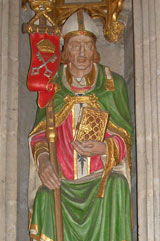 |
 |
 |
 |
 |
 |
 |
|
|
Thurstan, archbishop of York Thurstan had served in the royal households of William Rufus (1087-1100) and Henry I (1100-1135); the latter appointed him to the see of York in 1114. The early years of Thurstan’s office were troubled by the dispute between the archbishops of York and Canterbury, over the primacy of Canterbury.
Thurstan played a prominent role in the political events of 1138, and was largely responsible for summoning the English troops who successfully defeated the Scots at the Battle of the Standard. This guaranteed the safety of the north of England. Thurstan was also an active supporter of monasticism in the north of England and had particularly close links with the Cistercian abbeys of Byland, Fountains and Rievaulx, ‘the three great luminaries of the North’ [William of Newburgh, Augustinian Canon]. The Fountains community was especially indebted to Thurstan; it was he who sheltered the band of Benedictine monks who had fled from their abbey of St Mary’s, York, seeking simplicity and solitude. The archbishop accommodated the monks at his own manor and later provided them with land at Skelldale, where they established a community that later became the Cistercian abbey of Fountains. Thurstan remained a friend and patron. Shortly before his death in February 1140, Thurstan took the monastic habit at the Cluniac priory of Pontefract in Yorkshire, where he was buried in front of the High Altar. This was in fulfilment of a promise he had made at Cluny as a young man.
|
